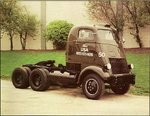A.J. Baime
Recruit
- 1
- Dec 12, 2012
Hello, my name is A.J. Baime. I'm a new member of this forum and a writer working on a book about the Willow Run bomber plant, which sought to build a B-24 bomber every hour during WWII—the most ambitious industrial experiment ever at the time. I would like to hear from anyone who worked at Willow Run, heard anything about Willow Run, had an opinion about Liberators made by Ford, or worked anywhere in Detroit during the war. Would anyone share any thoughts? I'd love to hear 'em!

